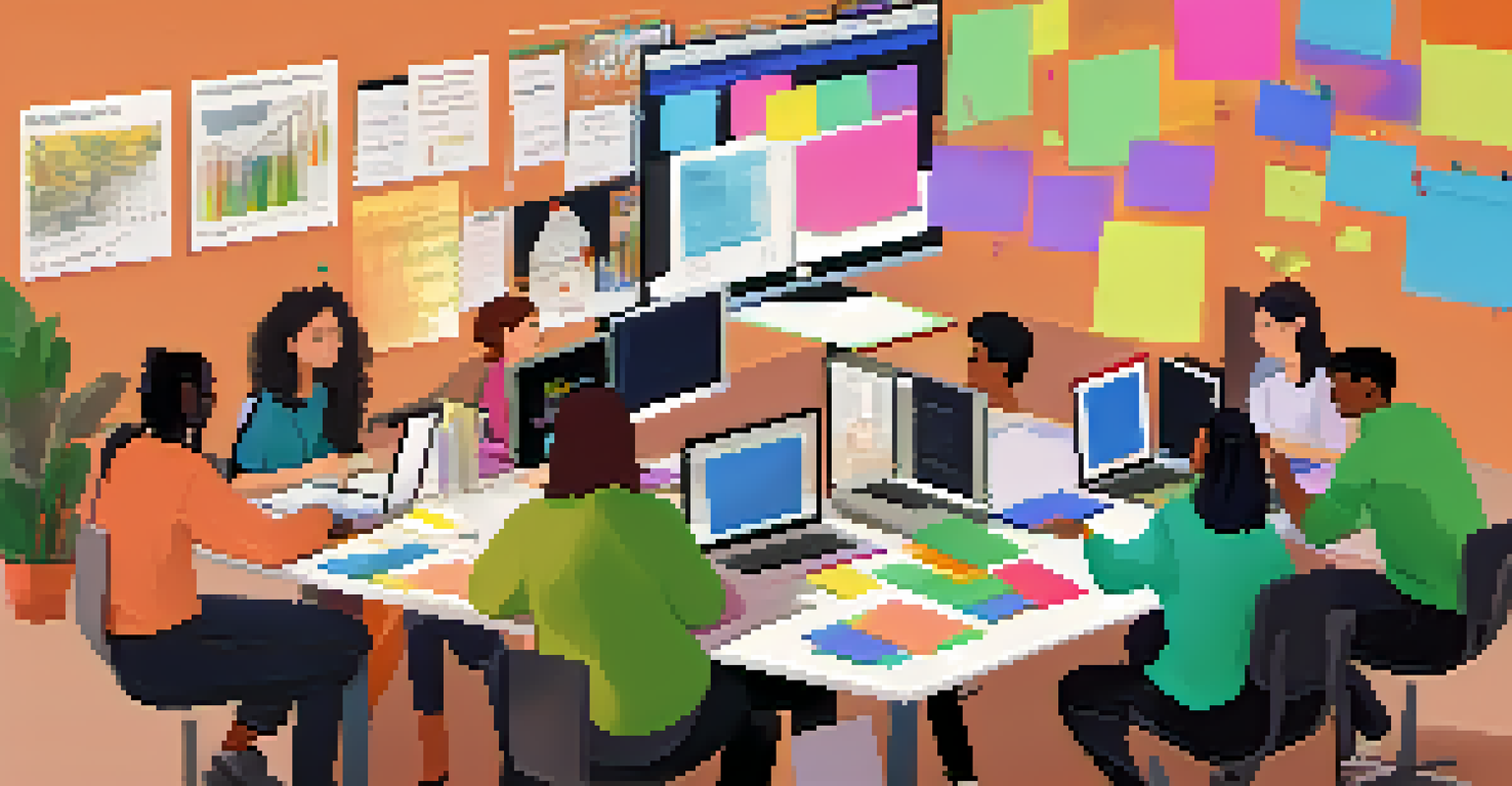The Importance of Digital Portfolios in Education Today

Understanding Digital Portfolios and Their Purpose
Digital portfolios are curated collections of a student's work, showcasing their skills, achievements, and growth over time. Unlike traditional portfolios, which may gather dust in a folder, digital versions are dynamic and easily accessible online. This format allows students to present their best work in a visually appealing way, making it more engaging for potential educators and employers.
The digital portfolio is a powerful tool for personal expression and creativity, allowing students to showcase their unique journeys and skills.
The primary purpose of a digital portfolio is to demonstrate a learner's journey, highlighting not just completed assignments but also reflections on the learning process. This encourages students to take ownership of their education, as they actively select what to include. By carefully curating their work, students can effectively communicate their personal brand and unique value.
Moreover, digital portfolios can be easily updated, allowing students to add new projects and skills as they progress. This adaptability is crucial in today's fast-paced digital world, where the ability to learn and grow is highly valued. In essence, digital portfolios serve as both a resume and a reflective journal, offering a comprehensive view of a student’s capabilities.
Enhancing Learning Through Reflection
Reflection is a cornerstone of effective learning, and digital portfolios provide an ideal platform for this practice. By encouraging students to think critically about their work, they can identify strengths and areas for improvement. This process not only reinforces learning but also builds essential skills like self-assessment and goal setting.

For instance, a student might include a piece of art in their portfolio and reflect on the techniques they used and what they learned throughout the creation process. This not only showcases their work but also demonstrates their growth as an artist. Such reflections can be incredibly valuable during job interviews or college applications, where candidates are often asked about their experiences.
Showcase Skills and Growth
Digital portfolios provide a dynamic way for students to present their work and reflect on their learning journey.
Furthermore, regular reflection helps instill a growth mindset, where students learn to view challenges as opportunities for development. They become more resilient, understanding that failure is not the end but a stepping stone to success. This approach fosters lifelong learning habits that extend beyond the classroom.
Digital Portfolios as a Bridge to Career Readiness
In today's job market, having a digital portfolio can be a game-changer for students entering the workforce. It allows them to showcase their skills and experience in a way that a traditional resume simply cannot. Potential employers can see a candidate's work firsthand, giving them a deeper understanding of their capabilities and creativity.
Reflection is the key to unlocking deeper learning, helping students grow and adapt in an ever-changing world.
For example, a student applying for a graphic design position can include links to projects they’ve completed, along with explanations of their design choices. This not only highlights their technical skills but also demonstrates their thought process and problem-solving abilities. Such insights can set a candidate apart in a competitive job landscape.
Additionally, as industries evolve, so do the skills needed to succeed. Digital portfolios can be tailored to highlight relevant skills for specific roles, making it easier for students to align their experiences with job requirements. This adaptability not only prepares students for their first job but also positions them for future career growth.
Fostering Creativity and Personal Expression
Digital portfolios are not just about showcasing skills; they're also a canvas for creativity and personal expression. Students can choose how to present their work, allowing them to infuse their personality into their portfolios. This creative freedom can be incredibly empowering, making the learning experience more enjoyable.
For instance, a student passionate about photography can use digital tools to create an interactive portfolio that includes multimedia elements like videos and sound. This not only makes their work more engaging but also enhances their technical skills as they learn to use various digital platforms. Creativity in presentation can leave a lasting impression on viewers.
Enhance Career Readiness
They serve as powerful tools for students to demonstrate their capabilities to potential employers in a visually engaging manner.
Moreover, personal expression through digital portfolios can help students connect with their audience on a deeper level. When students share their stories and experiences alongside their work, it humanizes their achievements, making them more relatable and memorable. This connection can open doors to networking opportunities and collaborations.
Encouraging Collaboration and Feedback
Digital portfolios facilitate collaboration among students, teachers, and mentors, creating a rich learning environment. By sharing their portfolios, students can receive constructive feedback from peers and educators, which is invaluable for growth. This collaborative approach encourages a sense of community and shared learning.
For example, a group project can culminate in a joint digital portfolio where each member contributes their work. This not only showcases individual contributions but also highlights the power of teamwork. The feedback received can help refine their projects and enhance overall quality, teaching students the importance of collaboration in real-world scenarios.
Additionally, collaboration fosters critical thinking, as students learn to articulate their ideas and consider different perspectives. Engaging in discussions about their portfolios can lead to insights they might not have considered on their own. This process not only improves their work but also builds essential communication skills.
Digital Portfolios in Diverse Learning Environments
One of the great advantages of digital portfolios is their versatility across various educational settings. They can be used in traditional classrooms, online learning environments, or even in informal settings like workshops and community programs. This adaptability makes them a valuable tool for diverse learners.
For instance, students with different learning styles can choose how they present their work—through videos, written reflections, or visual art. This choice empowers them to engage with their learning in a way that feels most authentic. In inclusive classrooms, digital portfolios can also accommodate students with disabilities, allowing them to showcase their work without barriers.
Foster Creativity and Collaboration
Digital portfolios encourage students to express themselves creatively while collaborating and receiving feedback from peers.
Moreover, digital portfolios can be a powerful tool for lifelong learners, enabling individuals to document their experiences beyond formal education. Whether someone is taking a workshop, attending a seminar, or pursuing a hobby, they can continue to build and reflect on their portfolio. This ongoing development is crucial in our ever-evolving world.
The Future of Digital Portfolios in Education
As technology continues to advance, the role of digital portfolios in education will only grow. We can expect to see more innovative tools and platforms that enhance the creation and sharing of portfolios. This evolution will likely make it easier for students to showcase their work and for educators to assess their progress.
Furthermore, the integration of digital portfolios into standardized education practices may become more common. Schools could implement guidelines for creating and maintaining portfolios as part of their curriculum, ensuring that all students benefit from this valuable resource. This shift could standardize how students present their skills and achievements.

In conclusion, embracing digital portfolios in education not only prepares students for the future job market but also enriches their learning experience. By fostering creativity, collaboration, and personal reflection, digital portfolios can transform how we approach education, making it more relevant and impactful for all learners.